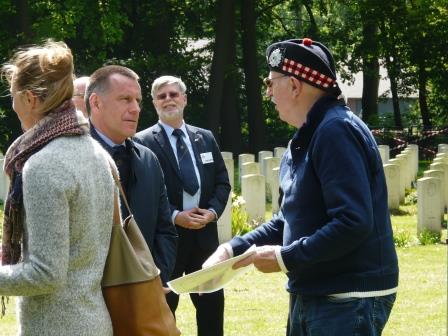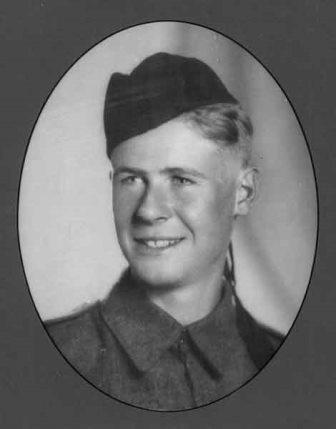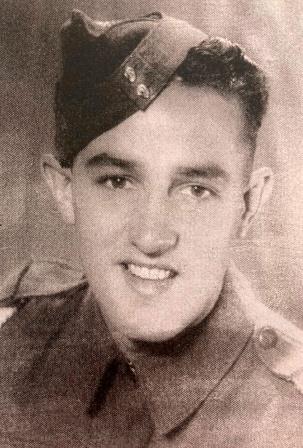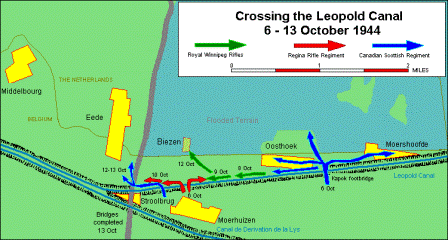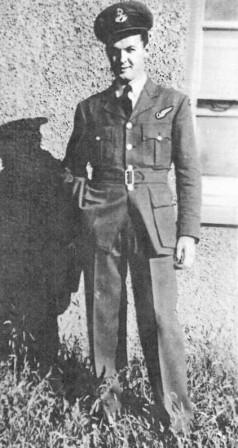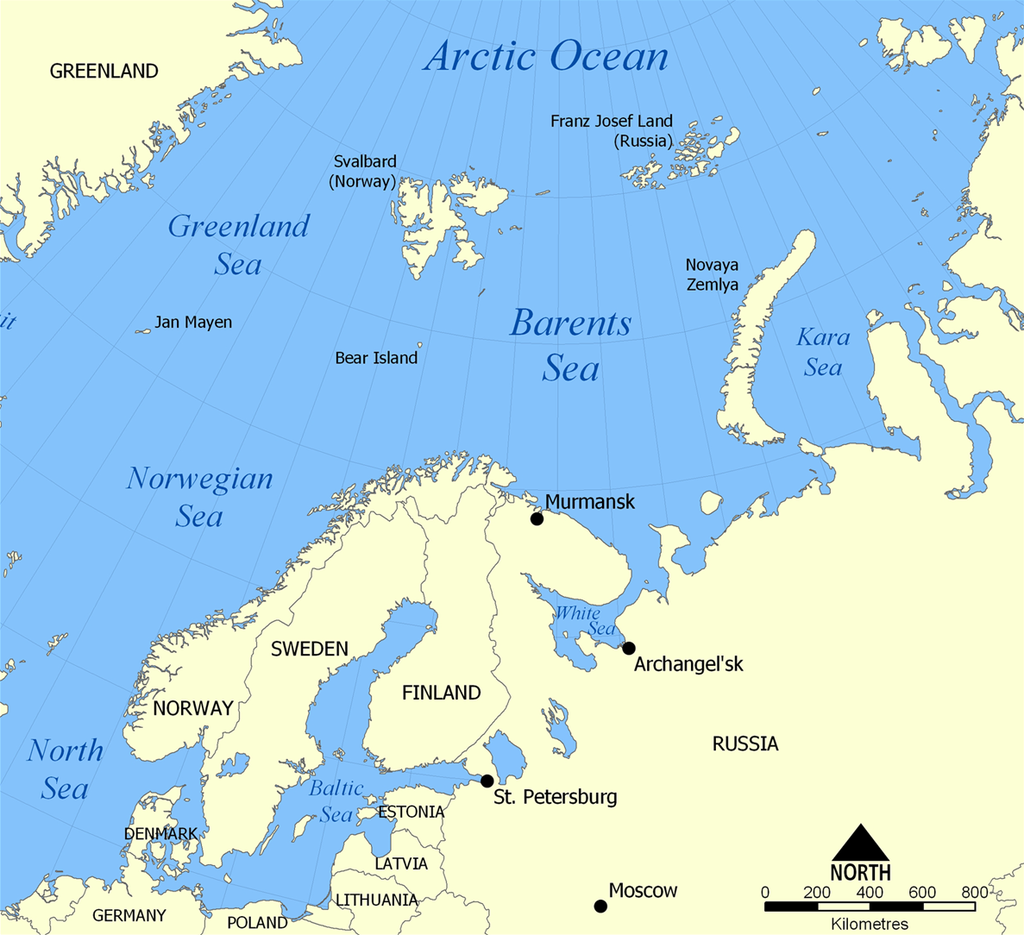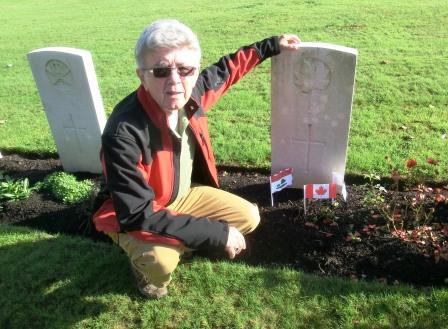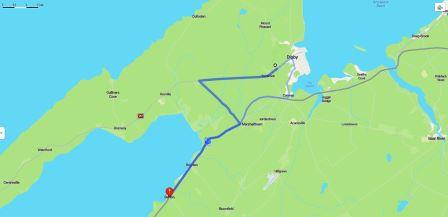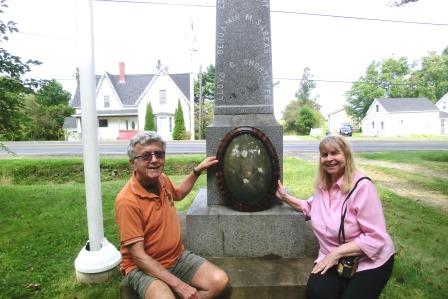January 25, 2023. After seeing an interview on CTV National News about Pieter’s research into WWII soldiers and airmen buried in The Netherlands, Pieter received an email from Dave Montgomery. (See Military researcher identifies 200 fallen soldiers | CTV News at https://www.ctvnews.ca/video?clipId=2561931)

Dave Montgomery, whose father’s best friend was RCAF Pilot George Glenn Millar. (Photo courtesy of Dave Montgomery)
Dave wrote that “…I became aware of your project of identifying Canadians killed in WW2 to liberate Holland when I saw your interview with CTV News recently.
My father’s best friend, George Glenn Millar, nicknamed ‘Dusty’, was killed on September 28, 1944 in combat while flying a Spitfire Mark IX over Nijmegen, Holland. He is buried at the Uden War Cemetery in North Brabant, Holland. He was from Winnipeg, Manitoba and was serving with 442 Squadron of the RCAF when killed. … My father survived the war and lived a full life back in Canada and passed away in January 2013. He never forgot his friend…”
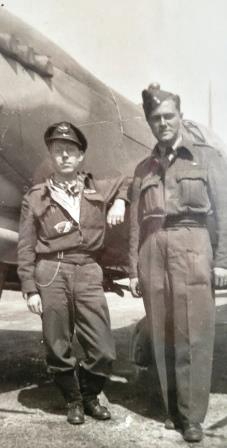
George Glenn ‘Dusty’ Millar, left, with Thomas Richard Montgomery. (Photo courtesy of Dave Montgomery)
Dave included a photo, explaining that “… G. G. Millar is on the left. My father, Thomas Richard Montgomery, is on the right….”
….George Glenn attended university for one year before enlistment….
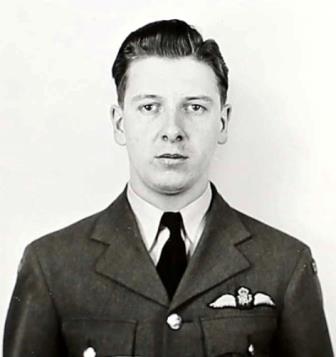
George Glenn ‘Dusty’ Millar. (Photo courtesy of the Information Centre, Holten)
Born November 21, 1921 in Winnipeg, Manitoba, George Glenn MILLAR was the son of George Sawers and Janet Smith (nee Wilson) Millar. While a first-year student at the University of Manitoba, George joined the University’s Canadian Officers’ Training Corps (COTC) on April 7, 1941, part of the Non-Permanent Active Militia. In his attestation form, he stated that he had served 110 hours in the University of Manitoba Training Unit (UMTU). (See https://en.wikipedia.org/wiki/Canadian_Officers%27_Training_Corps)
In July 1941, he enlisted in the Royal Canadian Air Force (RCAF) in Winnipeg. Asked about hobbies and sports, he wrote that he played golf extensively, occasionally played hockey, rugby, and baseball. He was very clear in his goal – he wanted to enlist for flying duties and to be a pilot.
….George Glenn realized his goal of becoming a pilot….
In October 1941 he was sent to Edmonton, Alberta and then a few weeks later to Calgary, Alberta to #3 Service Flying Training School for flight training. On December 12, 1941 he was sent back to Edmonton, to #16 Flight Training School, where he remained until April 25, 1942. By the time he left he had put in 73 hours and 35 minutes into flying a Tiger Moth.
He was next posted to #1 Service Flying Training School in Camp Borden, Ontario on April 26, 1942, receiving his Pilot Flying Badge on August 14, 1942. He had also learned to fly a Yale and a Harvard MK II.
In August 1942 he was posted to No. 133 (F) Squadron in Lethbridge, Alberta, where he gained more experience in flying a Harvard MK II and learned to fly a Hurricane II B. The Squadron moved to Boundary Bay, British Columbia at the beginning of October 1942. (Note: the ‘F’ stood for ‘Fighter’)
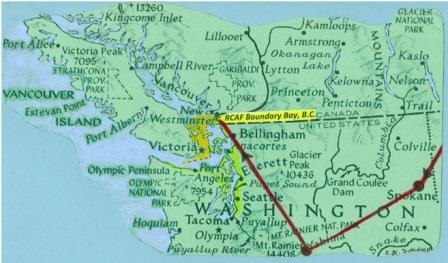
Patrol path of No. 133 (F) Squadron included the Canadian section [orange] and the area in the United States from Bellingham to Tacoma, Washington, [yellow]. (Map source: https://clarencesimonsen.wordpress.com/category/rcaf-133-squadron/)
On October 5, 1942, George Glenn received a promotion to Pilot Officer, and then another promotion, to Flight Officer, on February 13, 1943. He remained with No. 133 (F) Squadron until May 15, 1943, when he was sent to No. 111 Squadron in Anchorage, Alaska.
Don Smith, an Associate Historian with the RCAF, explained that George Glenn “….arrived at No. 111 Squadron as a replacement pilot. Millar was at No. 111 Squadron to get checked out in a new (for him) fighter type, the Curtis P-40K Kittyhawk. He had been flying the Hawker Hurricane with No. 133 Squadron….”
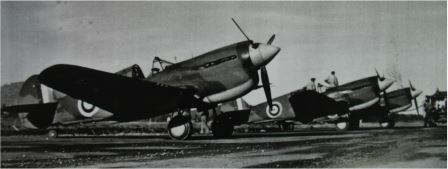
P-40 Kittyhawk. (Photo credit: Department of National Defence (DND) PGB-1436)
….George Glenn’s Squadron participates in the Aleutian Islands Campaign in 1943 ….
Don went on to explain that “…Millar did not remain long with No. 111 Squadron after he soloed in the Kittyhawk in late May 1943. By the end of August he was flying with No. 14 Squadron at Umnak Island, in the Aleutians, where he spent a one-week rotation at the forward assembly airfield on Amchitka Island the same month…”
Dave Montgomery had done some research on George’s time in Alaska, and explained that “…. No. 14 Squadron and No. 111 Squadron were ordered to Alaska in 1943 to fight alongside the Americans fighting the Japanese who had landed at Kiska and Attu Islands in the Aleutian Islands of Alaska in June of 1942.
These RCAF squadrons served at Anchorage, Kodiak Island, and Umnak Island bases with short postings to Adak Island and Amchitka Island when flying missions against the Japanese, who were dug in on Kiska Island.
Several were killed there as the weather was atrocious, especially in the Aleutians. Weather was the biggest killer of pilots in Alaska, not enemy guns.
G.G. Millar flew with both 111 Squadron (briefly) and then 14 Squadron and flew missions with the US fliers to Kiska Island bombing and strafing the Japanese there under overall command of Jack Chennault, the son of Claire Chennault who was the US Colonel (later General) who commanded the famous Flying Tigers in China!
No. 14 and 111 Squadrons returned to Patricia Bay in September of 1943 after the 5,000 Japanese on Kiska Island managed to escape under cover of fog and darkness in late July 1943 on Japanese naval destroyers sent there to evacuate them after the defeat of the Japanese forces on Attu Island by the US…..” RCAF Patricia Bay was in Victoria, British Columbia. (For more information on the Aleutian Islands Campaign, see https://en.wikipedia.org/wiki/Aleutian_Islands_campaign)
Don Smith explained that “…Millar remained with No. 14 Squadron, going overseas with them, where the Squadron was renumbered from No. 14 Squadron to No. 442 (F) Squadron…”
Dave Montgomery noted that “….No. 14 and 111 Squadrons sailed to England between January 20 to 27, 1944 on the SS Pasteur (a French passenger liner completed in 1939 and converted to a fast troop ship). The Pasteur made the crossing alone rather than in a convoy since she could sail at up to 26 Knots.
On February 8, 1944, No. 14 Squadron was renumbered as 442 Squadron (equipped with Spitfire Mark IX fighters) and No. 111 Squadron was renumbered as No. 440 Squadron (equipped with Hawker Typhoon fighter bombers)….”

Spitfire Mark IX. (Photo source: Google image, from ‘Spitfire Mk IX Performance Testing, Aeroplane and Armament Experimental Establishment, Boscombe Down, 21 October, 1942.’)
….George Glenn’s Spitfire failed to return from a patrol near Nijmegen….
On August 14, 1944, George Glenn received his final promotion, to Flight Lieutenant. Just over a month later, he had his final flight. Don Smith explained that from September 20 to October 1, 1944, Base 68 at Le Culot/Beauvechain in Belgium “…was occupied by 126 Wing, Group 83, 2nd Tactical Air Force (Canadian Fighter Wing), to provide air cover over the Arnhem/Nijmegen areas for Operation Market Garden….”
NOTE: Operation Market Garden was an Allied military operation, from September 17 to 27, 1944, that succeeded in liberating Nijmegen and Eindhoven but failed in liberating the last bridge held in Arnhem, which would enable troops to the Rhine into Germany. The movie ‘A Bridge Too Far’ dramatized this event. (See https://en.wikipedia.org/wiki/A_Bridge_Too_Far_(film))
It was from Base 68 at Le Culot/Beauvechain that George Glenn’s Squadron operated during that period. “….On September 28, 1944, while on a patrol over enemy territory in Spitfire PL490, his aircraft apparently ran out of fuel. F/L Millar was last seen over Nijmegen, Holland. While the record indicates F/L Millar’s aircraft ran out of fuel, the record for Spitfire PL490 suggests on 28 September, 1944, this aircraft, flown by F/L G.G. Millar, RCAF, was in aerial combat with Fw190s of the German Luftwaffe before the fuel shortage was reported….”
This summary was similar to what was written in a September 30, 1944 letter to George Glenn’s mother by his Commanding Officer in No. 442 Squadron, Flight Lieutenant W A Olmstead. “…On the morning of September 28th, Glen took off with the Squadron on a Patrol over enemy territory in Holland. During this operation the Squadron were chasing some German aircraft when Glen reported on his radio that he was getting low in fuel and would have to return to friendly territory which he started out to do.
Later during the operation, Flight Lieutenant W.A. Olmstead, who was leading the Squadron, heard Glen on his radio saying that his engine was cutting and he would have to bail out or crash land. He was not seen at this point by any member of the Squadron, but it is believed he bailed out or crash landed somewhere in Holland at approximately 0945 hours….”
The aircraft crashed 3 km (1.86 miles) southeast of Weibosch near Schijndel, in the Dutch province of Noord-Brabant.
….Why did the plane run out of fuel?….
We asked Don Smith why the Spitfire would have run out of fuel. He said that although it was possible that the Spitfire “…PL490 suffered battle damage if involved in aerial combat with Fw190s, this cannot be confirmed…”
Don went on to explain that “….the Merlin-powered Spitfire Mk IX was also known to have problems with vapour-lock in the fuel system, especially if the aircraft had been sitting in the sun prior to take-off. If the Spitfire PL490 was carrying an external belly-mounted auxiliary fuel tank at the time of its loss, this could create failure of the engine when switching from main tanks to external, or from external back to the main fuel tanks. The latter was more serious, since this would usually take place over enemy territory, as was the case on September 28, 1944.
As an example of this particular problem, No. 401 Squadron (RCAF) reported almost one quarter of pilots lost were due to this cause. These incidents were not mentioned as ‘tank problems’, but referred to such incidents as ‘engine failure’ or ‘engine trouble’.
The actual cause of the loss of Spitfire PL490 will probably never be known. The Spitfire Mk IX had two tanks in front of the cockpit, one upper and one lower. Later models had another fuel tank added behind the cockpit. It is possible that the lower front tank could have been holed in combat, or the rear tank, depending on the age of PL490. In either case, F/L Millar would not have noticed the fuel leak….”
….George Glenn Millar was buried in Uden War Cemetery….
Edwin van der Wolf, a volunteer researcher at the Canadian War Cemetery in Holten, wrote that George Glenn was temporarily buried in Weibosch before being reburied on July 23, 1946 at Uden War Cemetery in Uden, The Netherlands. (See https://www.cwgc.org/visit-us/find-cemeteries-memorials/cemetery-details/2082100/uden-war-cemetery/)

George Glen Millar is buried in Uden War Cemetery. (Photo courtesy Information Centre, Canadian Cemetery Holten)
Thank you to Dave Montgomery for sharing information about his father’s best friend, George Glenn Millar. He is not forgotten! Thank you to Don Smith for help with the aviation specifics and history, and to Edwin van der Wolf for sending photos and confirming burial information. If you have a story to share, please contact Pieter at memorialtrail@gmail.com, comment on the blog, or tweet to @researchmemori1.
© Daria Valkenburg
…Want to follow our research?….
If you are reading this posting, but aren’t following the blog, you are welcome to do so. Our blog address: https://onthewarmemorialtrail.com/.
 4 countries, 6 weeks, 7,000 km – an unforgettable war memorial journey in Europe…. Daria’s book ‘No Soldier Buried Overseas Should Ever Be Forgotten’ is available in print and e-book formats. Net proceeds of book sales help support research costs and the cost of maintaining this blog. For more information on the book, please see https://nosoldierforgotten.com/
4 countries, 6 weeks, 7,000 km – an unforgettable war memorial journey in Europe…. Daria’s book ‘No Soldier Buried Overseas Should Ever Be Forgotten’ is available in print and e-book formats. Net proceeds of book sales help support research costs and the cost of maintaining this blog. For more information on the book, please see https://nosoldierforgotten.com/
You are also invited to subscribe to our YouTube Channel: On The War Memorial Trail With Pieter Valkenburg: https://www.youtube.com/channel/UCJ591TyjSheOR-Cb_Gs_5Kw.
Never miss a posting! Subscribe below to have each new story from the war memorial trail delivered to your inbox.
